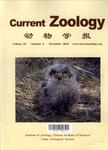Does defensive posture increase mimetic fidelity of caterpillars with eyespots to their putative snake models?
Does defensive posture increase mimetic fidelity of caterpillars with eyespots to their putative snake models?作者机构:Ottawa-Carleton Institute of Biology Carleton University 1125 Colonel By Drive Ottawa ON K1S 5B6 Canada Department of Biology Carleton University 1125 Colonel By Drive Ottawa ON K1S 5B6 Canada
出 版 物:《Current Zoology》 (动物学报(英文版))
年 卷 期:2014年第60卷第1期
页 面:76-89页
核心收录:
学科分类:0710[理学-生物学] 07[理学] 08[工学] 080203[工学-机械设计及理论] 09[农学] 0802[工学-机械工程]
基 金:Funding for this research was provided by a Discovery Grant (NSERC) awarded to TNS
主 题:Behaviour Geometr!c morphometrics Protective colouration Mimicry Morphology Vipers
摘 要:Organisms often evolve behaviours that increase or reinforce the protection from predators afforded by their morpho- logical defences. For example, mimetic animals may adopt postures or locomotory behaviours that emulate a characteristic fea- ture of their model to increase predator deception. Caterpillars with eyespots are thought to mimic snakes, and when threatened many of these caterpillars adopt a posture that appears to enhance this resemblance. Herein we evaluate the quantitative strength of evidence of behavioural mimicry in the caterpillars of 14 species by comparing how closely a series of putative snake-mimicking caterpillars resemble snakes while at rest and when threatened. Specifically, we quantified the head morphology and eye position of a range of snake species, as well as the shape of the apparent head (i.e. anterior body segments) and position of eyespots in caterpillars resting or in their defensive posture. This allowed us to objectively examine evidence for an increased resemblance to either snakes generally, or to Viperidae snakes specifically, upon adopting the defensive posture. Widening the anterior body segments during the defensive posture typically made caterpillars appear more viper-like as opposed to more snake-like in general. Enhanced resemblance to vipers upon mounting the defensive posture was apparent only from the dorsal view. Laterally, caterpillars more closely resembled snakes in the resting posture and shifting to the defensive posture instead reduced mimetic fidelity, Overall we found evidence for behavioural mimicry in all 14 species examined. We highlight that objectively quantifying mimetic fidelity can help identify key features involved in deception .



